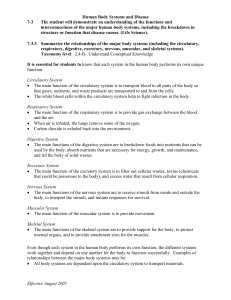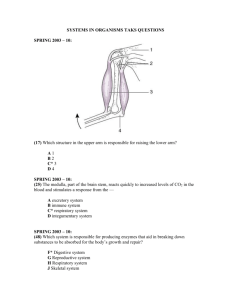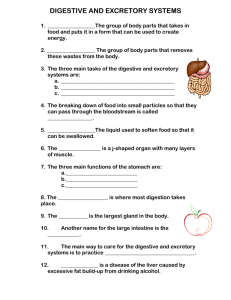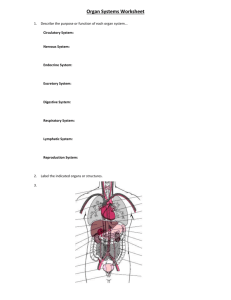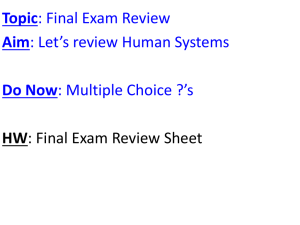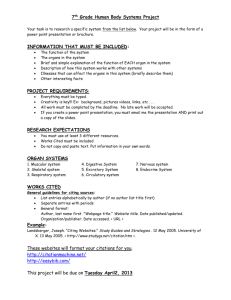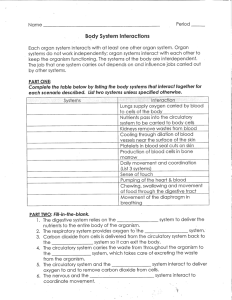UNIT 6 The Human Body Unit Exam
advertisement
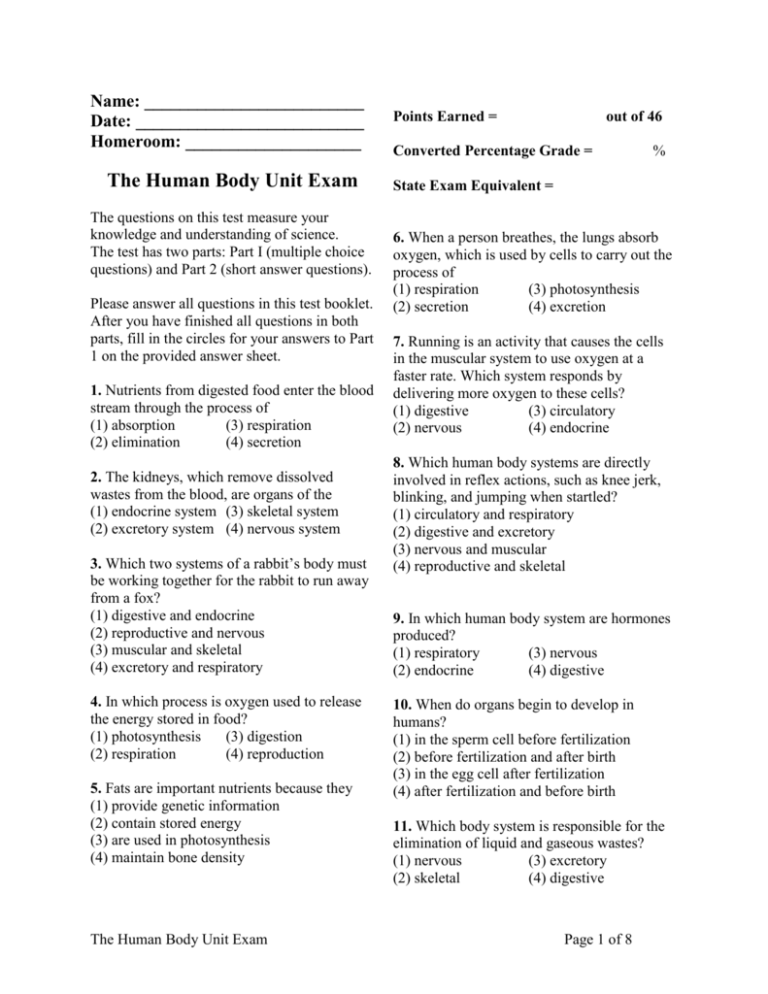
Name: _________________________ Date: __________________________ Homeroom: ____________________ The Human Body Unit Exam The questions on this test measure your knowledge and understanding of science. The test has two parts: Part I (multiple choice questions) and Part 2 (short answer questions). Please answer all questions in this test booklet. After you have finished all questions in both parts, fill in the circles for your answers to Part 1 on the provided answer sheet. 1. Nutrients from digested food enter the blood stream through the process of (1) absorption (3) respiration (2) elimination (4) secretion 2. The kidneys, which remove dissolved wastes from the blood, are organs of the (1) endocrine system (3) skeletal system (2) excretory system (4) nervous system 3. Which two systems of a rabbit’s body must be working together for the rabbit to run away from a fox? (1) digestive and endocrine (2) reproductive and nervous (3) muscular and skeletal (4) excretory and respiratory 4. In which process is oxygen used to release the energy stored in food? (1) photosynthesis (3) digestion (2) respiration (4) reproduction 5. Fats are important nutrients because they (1) provide genetic information (2) contain stored energy (3) are used in photosynthesis (4) maintain bone density The Human Body Unit Exam Points Earned = out of 46 Converted Percentage Grade = % State Exam Equivalent = 6. When a person breathes, the lungs absorb oxygen, which is used by cells to carry out the process of (1) respiration (3) photosynthesis (2) secretion (4) excretion 7. Running is an activity that causes the cells in the muscular system to use oxygen at a faster rate. Which system responds by delivering more oxygen to these cells? (1) digestive (3) circulatory (2) nervous (4) endocrine 8. Which human body systems are directly involved in reflex actions, such as knee jerk, blinking, and jumping when startled? (1) circulatory and respiratory (2) digestive and excretory (3) nervous and muscular (4) reproductive and skeletal 9. In which human body system are hormones produced? (1) respiratory (3) nervous (2) endocrine (4) digestive 10. When do organs begin to develop in humans? (1) in the sperm cell before fertilization (2) before fertilization and after birth (3) in the egg cell after fertilization (4) after fertilization and before birth 11. Which body system is responsible for the elimination of liquid and gaseous wastes? (1) nervous (3) excretory (2) skeletal (4) digestive Page 1 of 8 12. Which factor has the least effect on a person’s metabolism? (1) exercise (3) intelligence (2) hormones (4) diet 17. The diagram below shows a human body system. 13. What is the main function of the circulatory system? (1) secrete enzymes (3) produce hormones (2) digest proteins (4) transport materials 14. Infectious diseases are caused by (1) allergies (2) vitamin deficiencies (3) chemical spills (4) microorganisms 15. The diagram below represents a magnified view of an air sac in the human lung. The white arrows indicate blood flow. Which two systems are interacting in this diagram? (1) skeletal and muscular (2) nervous and endocrine (3) reproductive and digestive (4) respiratory and circulatory 16. The energy obtained from food is measured in units called (1) watts (3) degrees (2) Calories (4) pounds The Human Body Unit Exam What are two of the functions performed by this body system? (1) protects and supports the body (2) produces and transports oxygen (3) produces and excretes waste products (4) controls and coordinates body activities 18. The main function of the human digestive system is to (1) break down foods for absorption into blood (2) exchange oxygen and carbon dioxide in the lungs (3) release energy from sugars within the cells (4) carry nutrients to all parts of the body 19. Which sequence lists the levels of organization in the human body from simplest to most complex? (1) organ system → tissue → cell → organ (2) tissue → cell → organ → organ system (3) organ → organ system → tissue → cell (4) cell → tissue → organ → organ system 20. Which three systems of the human body function together to move and control body parts? (1) nervous, skeletal, and muscular (2) muscular, endocrine, and excretory (3) digestive, excretory, and reproductive (4) circulatory, endocrine, and respiratory Page 2 of 8 21. The labeled organs in the diagram below are part of which human body system? 24. Compared to the amount of hereditary information in a human body cell, how much hereditary information is contained in a human sex cell? (1) one-quarter the amount (2) one-half the amount (3) the same amount (4) twice the amount 25. Which term describes an organism’s ability to maintain a stable internal environment? (1) reproduction (2) extinction (3) locomotion (4) regulation (1) respiratory (2) endocrine (3) digestive (4) circulatory 22. The diagram below shows a human arm bending at the elbow. 26. In animal skin tissue, cell division is responsible for (1) growth and repair (2) sexual reproduction (3) obtaining energy (4) production of sex cells 27. Which unit is used to indicate the amount of energy in food? (1) ounce (3) calorie (2) degree (4) gram 28. The diagram below shows changes that a butterfly undergoes as it develops from an egg into an adult. Which two body systems most directly cause the arm to bend? (1) skeletal and muscular (2) reproductive and endocrine (3) respiratory and excretory (4) nervous and digestive 23. What is the result of cellular respiration? (1) Energy for cell processes is released. (2) Oxygen is released for photosynthesis. (3) Cells undergo decomposition. (4) Nutrients are excreted to prevent the buildup of body fat. The Human Body Unit Exam Which process is illustrated in the diagram? (1) mutation (3) germination (2) photosynthesis (4) metamorphosis Page 3 of 8 29. The table below shows the symptoms of some diseases that are caused by bacteria. Disease Symptoms botulism vomiting, abdominal pain, coughing, muscular weakness, visual disturbance pneumonia inflammation of lungs, fever, shortness of breath, fluid in lungs typhoid fever red rashes, high fever, intestinal bleeding tetanus uncontrolled contractions of voluntary muscles Which two diseases listed in the table affect the digestive system? (1) botulism and typhoid fever (3) tetanus and pneumonia (2) botulism and pneumonia (4) tetanus and typhoid fever 30. In humans, a fertilized egg contains 46 chromosomes. Which bar graph best represents the number of chromosomes contained in the sperm and egg before they united to make the fertilized egg? Base your answers to questions 31 and 32 on the diagram below and on your knowledge of science. The diagram shows four stages in the development of a human after fertilization. 31. Between stages A and D, which process must occur? (1) mutation (3) cell division (2) sexual reproduction (4) extinction 32. Which sequence of development is correct? The Human Body Unit Exam Page 4 of 8 Part 2: Answer all questions in this test booklet. 33. The two human body systems shown below interact to perform several functions for the whole organism. Describe how gas exchange occurs when the circulatory and respiratory systems work together. [2] __________________________________________________________ __________________________________________________________ __________________________________________________________ Base your answers to questions 34 and 35 on the chart below and on your knowledge of science. Each food in the chart is a particularly good source of the nutrient listed. Nutrient Food Source protein fish carbohydrate orange juice fat olive oil 34. Which nutrient listed in the chart is primarily responsible for growth and repair in the human body? [1] _________________________________________________________ 35. Which food source listed in the chart would provide a quick source of energy for the cells of the body? [1] _________________________________________________________ The Human Body Unit Exam Page 5 of 8 Base your answers to questions 36 and 37 on the diagrams below, which show a system in a human and a system in a plant. 36. Select one structure labeled in the human system above and explain how it contributes to the way the human system functions. [1] Human Structure: _______________________________________________ Explanation: __________________________________________________ __________________________________________________________ __________________________________________________________ 37. Select one structure labeled in the plant system above and explain how it contributes to the way the organism functions. [1] Plant Structure: _______________________________________________ Explanation: __________________________________________________ __________________________________________________________ __________________________________________________________ The Human Body Unit Exam Page 6 of 8 38. The diagram below shows several organs in the human digestive system. Explain two ways that food is changed as it passes through the digestive system. [2] (1) ________________________________________________________ (2) ________________________________________________________ Base your answers to questions 39 through 41 on the information below and on your knowledge of science. Maintaining a constant body temperature, no matter what the temperature of its surroundings, is a condition that needs to be balanced in many organisms. This ability is important to the organism’s survival. These organisms have many different body structures and behaviors that help maintain a constant body temperature. 39. Whales have a thick layer of blubber (fat) under their skin. How does this blubber help the whales to maintain a constant body temperature? [1] __________________________________________________________ __________________________________________________________ 40. Humans sweat when they are in the hot sun. How does sweating help humans to maintain a constant body temperature? [1] __________________________________________________________ __________________________________________________________ 41. Foxes living in different parts of the world have different-sized ears. The arctic fox, which lives in cold climates, has small ears. The desert fox, which lives in hot climates, has large ears. How does ear size help each of these foxes to maintain a constant body temperature? [1] __________________________________________________________ __________________________________________________________ The Human Body Unit Exam Page 7 of 8 42. Humans have several organ systems that allow them to carry on all life activities. Complete the chart below by identifying one organ system that is responsible for each life activity listed. The first row has been completed as an example. [3] Life Activity breaking down large food molecules into smaller molecules Human Organ System digestive system exchanging gases between the blood and the environment removing liquid and gaseous wastes from the body transporting needed materials to the cells and carrying wastes away from cells producing offspring moving the body The Human Body Unit Exam Page 8 of 8


